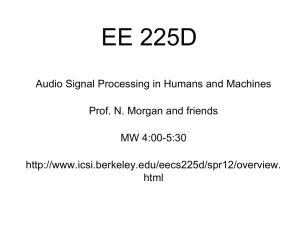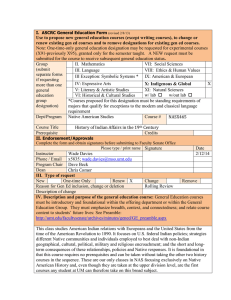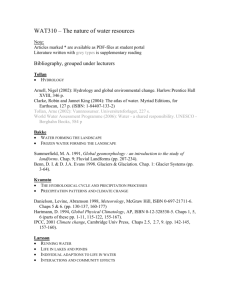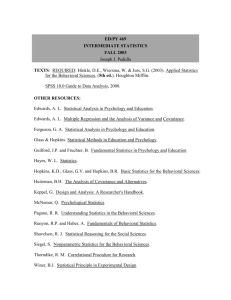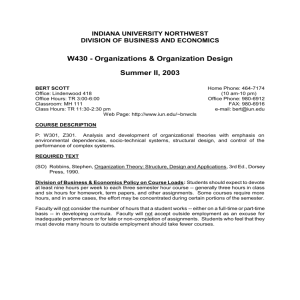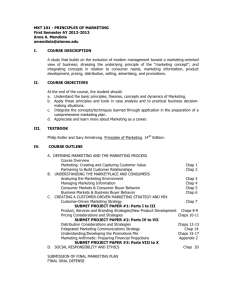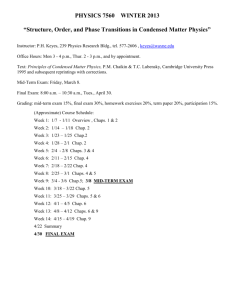I. ASCRC General Education Form Group Perspectives
advertisement
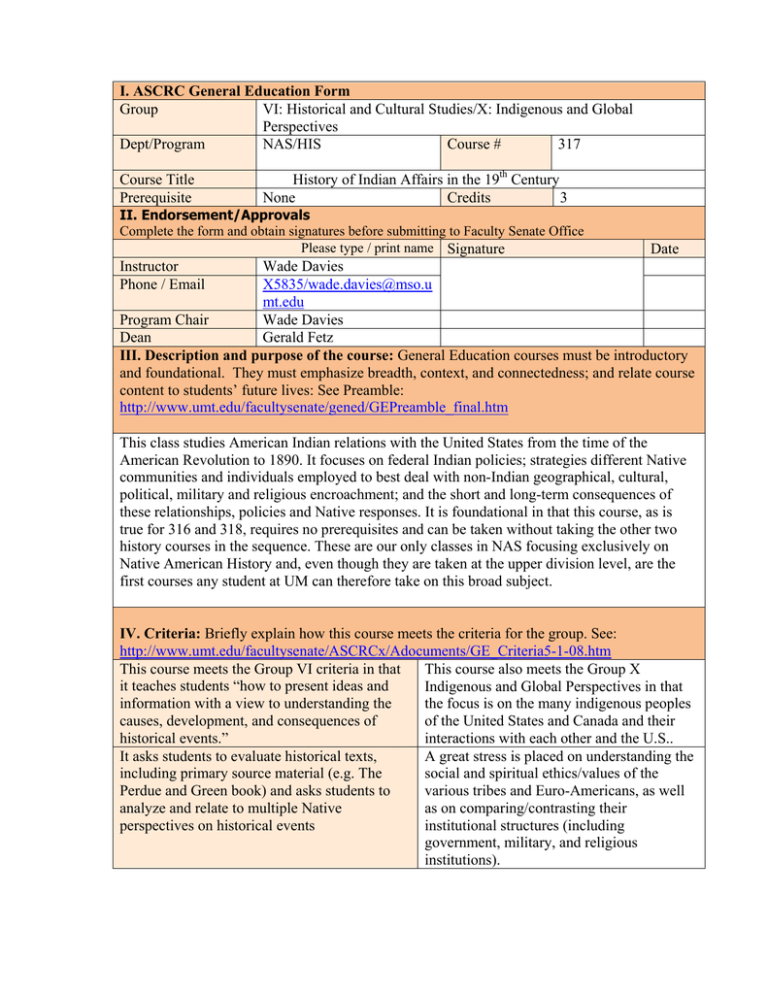
I. ASCRC General Education Form Group VI: Historical and Cultural Studies/X: Indigenous and Global Perspectives Dept/Program NAS/HIS Course # 317 Course Title Prerequisite History of Indian Affairs in the 19th Century None Credits 3 II. Endorsement/Approvals Complete the form and obtain signatures before submitting to Faculty Senate Office Please type / print name Signature Date Instructor Phone / Email Wade Davies X5835/wade.davies@mso.u mt.edu Program Chair Wade Davies Dean Gerald Fetz III. Description and purpose of the course: General Education courses must be introductory and foundational. They must emphasize breadth, context, and connectedness; and relate course content to students’ future lives: See Preamble: http://www.umt.edu/facultysenate/gened/GEPreamble_final.htm This class studies American Indian relations with the United States from the time of the American Revolution to 1890. It focuses on federal Indian policies; strategies different Native communities and individuals employed to best deal with non-Indian geographical, cultural, political, military and religious encroachment; and the short and long-term consequences of these relationships, policies and Native responses. It is foundational in that this course, as is true for 316 and 318, requires no prerequisites and can be taken without taking the other two history courses in the sequence. These are our only classes in NAS focusing exclusively on Native American History and, even though they are taken at the upper division level, are the first courses any student at UM can therefore take on this broad subject. IV. Criteria: Briefly explain how this course meets the criteria for the group. See: http://www.umt.edu/facultysenate/ASCRCx/Adocuments/GE_Criteria5-1-08.htm This course meets the Group VI criteria in that This course also meets the Group X it teaches students “how to present ideas and Indigenous and Global Perspectives in that information with a view to understanding the the focus is on the many indigenous peoples causes, development, and consequences of of the United States and Canada and their historical events.” interactions with each other and the U.S.. It asks students to evaluate historical texts, A great stress is placed on understanding the including primary source material (e.g. The social and spiritual ethics/values of the Perdue and Green book) and asks students to various tribes and Euro-Americans, as well analyze and relate to multiple Native as on comparing/contrasting their perspectives on historical events institutional structures (including government, military, and religious institutions). As explained relative to the Group 6 criteria, It has a broad chronological focus and deals with diverse tribes from throughout North this class has a broad cultural, geographic America and Canada. It includes discussions of and chronological focus both historical interpretation (historiography— including asking students to consider multiple historians’ interpretations of the same events) and ethnographic analysis. V. Student Learning Goals: Briefly explain how this course will meet the applicable learning goals. See: http://www.umt.edu/facultysenate/ASCRCx/Adocuments/GE_Criteria5-1-08.htm This class meets the learning goals for Group VI Students are expected to meet the Group X in that it expects students to “synthesize ideas learning goals in that they must demonstrate and information” and tests for this skill in both in exam essays and papers an understanding essay exam and paper assignments. of the interdependence among (and conflicts between) various indigenous peoples, as well as among those peoples and Europeans. In these assignments, they must also demonstrate “an awareness of the diverse ways humans structure their lives; and social, political, and cultural lives” The class asks students to evaluate one extended The course focuses on previous centuries, but students are asked to consider how the historical text (i.e. Perdue and Green) and past events continue to affect modern Native expects them to demonstrate an ability to American communities, including the explain the multiple causes of historical events, legacies of land, resource and population as well as to offer alternate courses of actions, loss and religious conversion efforts. We various groups could have taken to alter also stress the links between these past outcomes. In doing so, they must show an ability to understand the historical situation and actions and modern U.S. federal Indian law, including in terms of the rights and make logical speculations based on those responsibilities of citizenship. realities. This also meets the third stated learning goal in the group criteria in that the must put themselves in the shoes of various actors with different cultures and motivations. VII. Syllabus: Paste syllabus below or attach and send digital copy with form. ⇓ The syllabus should clearly describe how the above criteria are satisfied. For assistance on syllabus preparation see: http://teaching.berkeley.edu/bgd/syllabus.html NAS/HIS 465-01 History of Indian Affairs 1776 to 1890 Dr. Davies MWF 10:10-11:00 LA 244 Office: NAS 106 Office phone: 243-5835 email: wade.davies@mso.umt.edu Office hours: 11:10-12:30 MWF and 12:40-1:30 TR Course Description: This class studies American Indian relations with the United States from the time of the American Revolution to 1890. It focuses on federal Indian policies; strategies different Native communities and individuals employed to best deal with non-Indian geographical, cultural, political, military and religious encroachment; and the short and longterm consequences of these relationships, policies and Native responses. Course Objectives: Students should leave the course with: 1. the ability to describe changing political and legal relationships Native Americans had with the United States federal government and other key non-Indian groups during this time period. 2. knowledge of key federal Indian policies 3. the ability to pinpoint where and when the communities and nations covered in this course lived. 4. the basic knowledge and analytical skills necessary to explain how and why different Native communities responded to non-Indians as they did. 5. the ability to explain what alternative, but historically reasonable, responses Native communities could have made, and explain the likely outcomes of such actions. 6. the ability to critically analyze treaty documents Required Readings: R. David Edmunds. Tecumseh. James P. Ronda. Lewis and Clark among the Indians. Theda Perdue and Michael Green eds. The Cherokee Removal. David Nichols. Lincoln and the Indians. James Welch. Killing Custer. Various readings available on electronic and traditional reserve Course Requirements: Three Exams: 20 points each=60 points Three Papers: 10 points each=30 points Attendance and Participation: 10 points Total class points possible=100 Course Grade: Please note that NAS courses cannot be taken pass/no pass. The final course grade will be determined by total points earned out of a possible 100. 92-100=A 90-91=A88-89=B+ 82-87=B 80-81=B78-79=C+ 72-77=C 70-71=C68-69=D+ 62-67=D 60-61=D59 or lower=F Examinations: Each exam covers lecture and reading material presented in that third of the course. They are composed of short answer and essay questions worth a total of twenty points. Please bring a blue book from the bookstore for each test. Papers: There are three five to six-page papers (10 points each) required on three of the texts: Tecumseh, The Cherokee Removal, and Killing Custer. I will hand out specific questions on each book that will be the basis for each paper. None of the papers require any additional outside research. Attendance and Participation: Attendance is required. Consistent attendance, participation in class discussions, participation in smaller group discussions, and signs of extra effort make up this 10-point portion of the grade. Make-ups and Late Papers: A missed exam cannot be made-up unless you have made arrangements with me ahead of time. I may allow make-ups after-the-fact providing that you contact me as soon as possible after missing an exam with an excuse that I approve. Papers are due on the specified date and must be turned in during class. A three point deduction (30%) will be assessed for late papers. Calendar: Have the assigned readings completed for the dates indicated. Readings marked as “ERES” are available either as electronic reserve or in hard copy at the library. Week 1: 1/23 Introduction 1/25 Tecumseh chap. 1 Week 2: 1/28 Tecumseh chaps. 2-4 1/30 Tecumseh chap. 5 2/1 finish Tecumseh Week 3: 2/4 First Paper due on Tecumseh 2/6 Lewis and Clark chaps. 1-2 2/8 Lewis and Clark chaps. 3-4 Week 4: 2/11 Lewis and Clark chaps. 5-8 2/13 finish Lewis and Clark 2/15 no reading assignment Week 5: 2/18 President’s Day, No Classes 2/20 First Exam 2/22 The Cherokee Removal Preface, Introduction and chap. 1 Week 6: 2/25 The Cherokee Removal chaps. 2-3 2/27 The Cherokee Removal chap. 4 2/29 The Cherokee Removal chap. 5 and Epilogue Week 7: 3/3 Second Paper Due—The Cherokee Removal 3/5 Lincoln and the Indians chap. 1 3/7 Lincoln and the Indians chap. 2 Week 8: 3/10 Lincoln and the Indians chaps. 3-5 3/12 Between Two Fires from ERES chap. 2-3 3/14 Between Two Fires from ERES chap. 5 Week 9: 3/17 Lincoln and the Indians chaps. 6-7 3/19 Lincoln and the Indians chaps. 8-9 3/21 Second Exam SPRING BREAK: 3/24-3/28 Week 10: 3/31 Lincoln and the Indians chaps. 10-13 4/2 Lincoln and the Indians chap. 14 4/4 Killing Custer prologue and chap. 1 Week 11: 4/7 Killing Custer chaps. 2-5 4/9 Killing Custer chap. 6 4/11 Killing Custer chap. 7 Week 12: 4/14 Killing Custer chaps. 8-9 4/16 Killing Custer 10-epilogue 4/18 Killing Custer afterword Week 13: 4/21 Third Paper Due—Killing Custer 4/23 Hoxie article from ERES 4/25 “Kill the Indian and Save the Man” from ERES Week 14: 4/28 no reading assignment 4/30 no reading assignment 5/2 prepare to review for Final Final 10:10-12:10 Friday May 9th *Please note: As an instructor of a general education course, you will be expected to provide sample assessment items and corresponding responses to the Assessment Advisory Committee.

